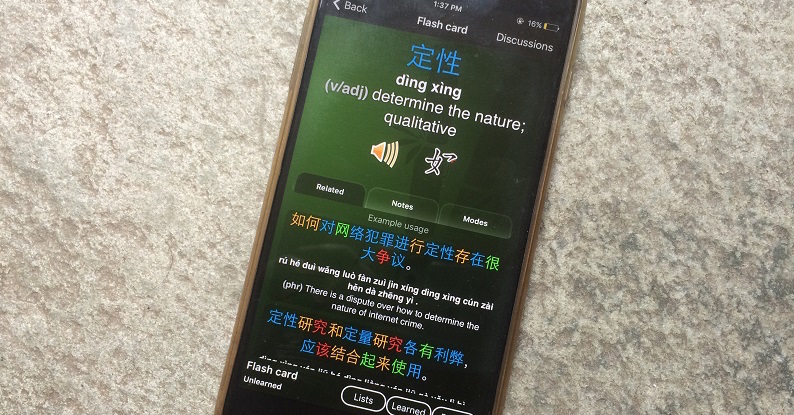Tech Savvy Student: 11 Digital Tools That'll Help Boost Your Mandarin
The Beijinger’s Mandarin Month series, running daily ahead of our June 25 Mandarin Mixer, is our attempt to whip Beijing into a Mandarin-learning frenzy. Today's post focuses on some of our favorite digital tools to help you improve your Chinese fluency.
Mastering a language as complex as Mandarin is tough no matter how you slice it. Thankfully, nearly all of us carry in our pockets enough technological horsepower to give you a shortcut to learning Mandarin. Here are five of the best tech tools we've come across to boost your Chinese studies.
Pleco
Pleco is hands down the most comprehensive and well-known Chinese dictionary app, with iPhone and Android versions. Based on an extensive and authoritative Chinese-English dictionary, the initial program is free but also has a massive array of paid add-ons that add functionality such as optical character recognition, extended dictionaries, additional fonts and audio. Pleco also has a well-regarded flash card program that uses a spaced repetition algorithm that maximizes the efficiency of reviewing your flashcards. Most add-ons go from USD 4.99 to USD 14.99, and bundles of multiple add-ons go all the way up to USD 79.99.
Tom Arnstein, tbj's web editor and an impassioned Mandarin student, suggests users buy the entire USD 79.99 pack. That way, they will have access to the flashcards, the OCR (a feature that reads characters via your smartphone's camera, before offering translations) and more. "It's worth it because, if you start studying Mandarin full on, you'll probably want to buy all of those features at some point anyway,so you might as well buy them all together, rather than spending so much on them piece by piece," he says.
Memrise
Arnstein also recommends this free app because it features vocabulary packs that other users have compiled. He also likes how it drills users in multiple ways like character practice and audio tests. But his favorite aspect of Memrise is how it lets users upload their own mnemonics for character sets. "Someone will say: 'This character looks like a bird flying over a tree,' and that kind of thing can be the best way to remember certain characters," Arnstein says. "Those mnemonics can sometimes vary in usefulness, but it's a nice touch."
Trainchinese
This combination dictionary/flashcard resource is similar to Pleco, and comes in iPhone, Android and web-based versions. Perhaps its best feature is a great flash card system that allows the user to set their preference for several modes of training repetition to help with memorization. A great dictionary with plenty of example sentences and audio anchors the program, and their support staff is always willing to add example sentences and characters not found in the system. The app is free for the first couple of lists and prices go up from there – a full-featured lifetime subscription runs USD 79.99.
Ninchanese
This handy web-based learning resource touts itself as a way to learn Chinese "more adorably and effectively." The main page of its website has colorfully engaging lessons with practical themes such as asking for directions, learning to count, saying hello, and asking for help at the bank. Users have given enthusiastic testimonials, including one named Norena who wrote that Ninchanese is "absolutely awesome" because of its "cute and fun design, which makes learning Chinese an exciting game and manages to give the language a welcoming and positive you-can-do-it vibe." Users can play around with a fairly extensive free version or upgrade to get full access for USD 10 a month or USD 96 a year.
The Chairman's Bao
One of the challenges of learning Chinese is the dearth of interesting, contemporary reading material tailored to differing levels of Chinese. That's where The Chairman's Bao comes in: their service provides short, digestible and fully annotated Chinese articles sorted by the HSK level of the reader. Each article is brief enough to be digestible yet long enough to be challenging. There's an audio recording for each, as well as vocabulary and grammar notes for each lesson. The free version of the app allows access to plenty of articles to get started; to access their archive of 1,000 annotated news articles requires a premium subscription that runs USD 10 for a month and USD 80 for a year.
Learn Chinese (available for iOS and Android)
This app (free for basic use, costing USD 4.99 for in-app purchases) was one of the most highly touted Mandarin learning tools in a roundup by the popular Fueled Blog. The author praised the app as a practical resource and "a great way to pick up essential phrases," before adding that "It also sounds out the words to help you practice."
Mango
Many users have turned to Mango to bolster their listening and speaking skills. PC Magazine praised its "interesting additional content, including movies," but said that its instruction was "tedious." The reviewer also complained about how Mango doesn't teach foreign alphabets or scripts. However Bobby Jencks, a Beijing international school teacher, vlogger and student of Mandarin, gave a more positive review in a recent WeChat post. He liked Mango's incorporation of practical phrases and its great pronunciation assistance, adding that the lessons are fun and provide some insight into Chinese culture. However, he was also disappointed by how Mango neglects reading and writing, and said that the app's USD 20 monthly fee was a bit steep.
Chinese Pod
This podcast uses fun, engaging everyday dialogues chock full of practical vocabulary. You can access 100 podcasts for free, but most users recommend upgrading to the USD 29 per month premium level, which unlocks Chinese Pod's entire library of podcasts, printable lesson notes, custom vocabulary lists, access to its app, and more.
Popup Chinese
A popular website that provides free podcast lessons, sample HSK tests, annotated readings, dialogue transcripts and more.
Perapera
After installing this free add-on to their Mozilla Firefox and Google Chrome browser, Perapera users can easily translate any characters that appear on their computer screens with a simple mouse point. Its website also has a section with language learning hacks, recommendations for other study resources, and more.
Skritter
Priced at USD 14.99 per month, Skritter is an inexpensive and highly practical resource for memorizing and characters, along with learning their meanings pronunciations and – best of all – how to write them. One reviewer raved about how this smartphone app doesn't merely task users with tracing characters, but instead grades them on each stroke before providing instant feedback.
And there you have it! Be sure to pre-register for our June 25 Mandarin Month mixer (by clicking here) to take advantage of free booze, schmoozing with Mandarin teachers and fellow students, and more.
Also, keep checking our Mandarin Month page for new articles about the wonderful world of Chinese language learning.
Mandarin Month is brought to you by Pleco, Project Pengyou, and Ninchanese.
Related stories :
Comments
New comments are displayed first.Comments
![]() admin
Submitted by Guest on Sun, 06/12/2016 - 14:46 Permalink
admin
Submitted by Guest on Sun, 06/12/2016 - 14:46 Permalink
Re: Tech Savvy Student: 11 Digital Tools That'll Help Boost...
Hello, what is the app on the picture?
that's trainchinese.com
![]() WayDaLone
Submitted by Guest on Sun, 06/05/2016 - 12:47 Permalink
WayDaLone
Submitted by Guest on Sun, 06/05/2016 - 12:47 Permalink
Re: Tech Savvy Student: 11 Digital Tools That'll Help Boost...
What`s the best free translator app? and the best paid for translator app?
I do not speak enough Chinese to carry on even a simple conversation.
I would like to be able to speak English into my phone and have my words displayed as text, then make a click, and have what I have just said spoken in Chinese as well as displayed in Chinese text?
Also, I don`t know why someone hasn`t come up with a stand alone translator. Just a handheld device that a person speaks into in their own language and their voice/words are said/displayed and when the other person of a different language speaks/answers in their language the same thing happens.
The device could just sit on a table between two people of two different languages and all they have to do is speak to each other and the device would handle the translation and communication would happen. Seems like a no-brainer considering all the high-tech tech out there.
Validate your mobile phone number to post comments.








